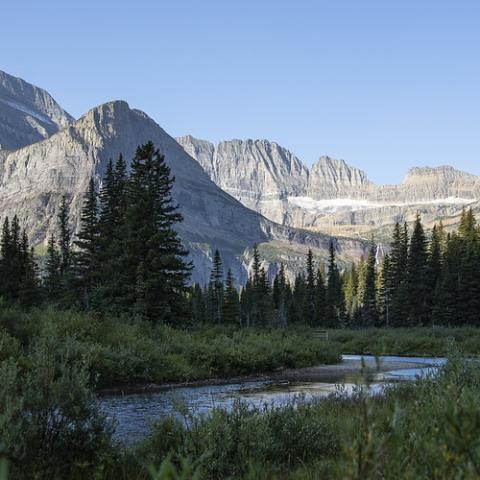
A home built next to McDonald Creek in Glacier National Park won't be torn down because the Montana lacks jurisdiction over it/Rebecca Latson file
Editor's note: This updates to reflect that Glacier National Park staff are consulting with Interior Department attorneys to determine whether they should pursue the matter.
A vacation home built in Glacier National Park next to McDonald Creek will not be torn down because the Montana agency that brought the case has no jurisdiction in the national park, a federal magistrate ruled Monday.
Whether the federal government seeks to have the house built on a half-acre private inholding removed is another matter.
The home's owners, John and Stacy Ambler of San Diego, argued last month in their bid for a summary judgment that the Flathead Conservation District had no authority in the park. Even if that were true, the district countered, the construction also was in violation of the National Environmental Policy Act and other laws. Park officials were consulting with Interior Department attorneys to determine if they should take any action.
The Amblers' inholding once was part of a larger 182-acre tract Charles Howe acquired in 1908 near present-day Apgar on the west side of the park through the Homestead Act of 1862. While portions of the larger tract had been acquired over the years by the federal government, the Amblers' plot and some others have remained privately held.
When locals noticed that construction of the home had encroached onto a nearby streambed, they alerted the conservation district, which has the authority to interpret and enforce the Montana Natural Streambed and Land Preservation Act. That law strictly governs construction near sensitive waterways. As part of an investigation, FCD determined the Amblers never secured the necessary permits to build the home. The conservation district ordered the home torn down and instructed the Amblers to apply for proper permitting before attempting to rebuild.
The Amblers last December sought a summary judgment ruling against FCD, maintaining that the federal government had exclusive jurisdiction over private property within the national park, except went it came to the state acting on civil or criminal matters within the park.
U.S. Magistrate Kathleen L. DeSoto agreed, citing a 1968 case that also revolved around a water rights dispute involving private property within Glacier. That case, Macomber v. Bose, reached the 9th U.S. Circuit Court of Appeals, which held that the ceding of the land for the park gave the federal government "not only the public lands dedicated to park purposes by the United States but all privately owned lands within the described park boundaries."
"...[b]y this cession and acceptance, federal authority became the only authority operating within the ceded area[,]” the Ninth Circuit ruled in Macomber, and concluding that “[s]tate law theretofore applicable within the area was assimilated as federal law, to remain in effect until changed by Congress.”
While FCD attorneys argued that the Streambed Act applied because when the federal government accepted the land for the national park it also "assimilated all Montana Law," the Amblers countered that only those laws in effect at the time of the land transfer were conveyed to the federal government and that the Streambed Act wasn't created until 1976, 66 years after Glacier was established.
DeSoto agreed [ruling attached below] and also noted that while the National Park Service has exclusive jurisdiction in the park, it has not adopted any "federal regulations governing construction on streambanks on private inholdings, or requiring residences constructed on private land in Glacier National Park to comply with the Streambed Act."
While FCD argued that the house's construction violated federal law, in part because it was "on the immediate bank of a perennial stream without a permit” and so constituted “a nuisance under federal law,” and also violated NEPA, and "a federal statute providing that “no permit, license, lease or other authorization” for the erection and maintenance of summer homes or cottages within Glacier National Park shall be granted…” the magistrate said those arguments were outside the issues raised by the Amblers' lawsuit.
"The sole issue before the Court is whether the FCD has jurisdiction to enforce the Streambed Act on the Ambler Property. FCD may be correct that the home the Amblers have built on their property is prohibited by federal law. But because these issues go beyond the scope of the narrow jurisdictional issue presented on summary judgment, the Court does not address FCD’s arguments," she wrote.
"In sum, the Court concludes that FCD lacks jurisdiction to enforce the Streambed Act on the Ambler Property because Montana has ceded exclusive jurisdiction over all land within the boundaries of Glacier National Park— including private inholdings—to the federal government," the magistrate concluded.




 Support Essential Coverage of Essential Places
Support Essential Coverage of Essential Places






